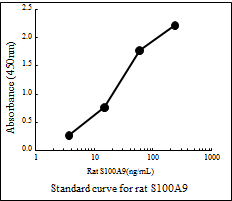Rat S100A9 assay kit
Calprotectin consists of two proteins, S100A8 and S100A9, and is known as a biomarker of inflammatory bowel disease. Yamasa Corporation developed ELISA for measurement of rat S100A9 using an anti-S100A9 monoclonal antibody. Using this ELISA, we measured an S100A9 level in feces, collected from a rat model of dextran sulfate sodium (DSS) -induced ulcerative colitis (UC), and demonstrated an increased level of S100A9 in the early stage of inflammation, thereby providing an indicator of UC 1).
Using this ELISA, a rat S100A9 assay kit was produced.
– ELISA with a 96-well microtiter plate.
– Rat S100A9 levels can be measured in a range of 3.75-240 ng/mL.
– Measurement time: primary reaction, 2 hours; secondary reaction, 1 hour: and color reaction, 20 minutes
– Rat serum and fecal*1 S100A9 levels can be measured.*2
*1: The measurement of fecal S100A9 levels requires extraction procedures. For details, see (1) of “Notes of measurement.”
*2: Samples need to be diluted before measurement. For details, see (2) of “Notes of measurement.”
Sandwich ELSIA with two kinds of mouse monoclonal anti-rat S100A9 antibody
– Product code: 80126
– Components:
| Name | Volume | Quantity | |
|---|---|---|---|
| ① | Antibody Coated Plate | 96-well microtiter plate | 1 plate |
| ② | S100A9 Standard 1 (3.75 ng/mL) | 0.5mL | 1 vial |
| ③ | S100A9 Standard 2 (15 ng/mL) | 0.5mL | 1 vial |
| ④ | S100A9 Standard 3 (60 ng/mL) | 0.5mL | 1 vial |
| ⑤ | S100A9 Standard 4 (240 ng/mL) | 0.5mL | 1 vial |
| ⑥ | Concentrated Diluent | 25mL | 1 vial |
| ⑦ | Concentrated Washing Solution | 50mL | 1 vial |
| ⑧ | Enzyme Conjugate | 0.15mL | 1 vial |
| ⑨ | Color Developing Reagent A | 11mL | 1 vial |
| ⑩ | Color Developing Reagent B | 0.5mL | 1 vial |
| ⑪ | Stop Solution | 11mL | 1 vial |
– Storage: 2-8℃
– Shelf life: 24 months after the date of manufacture
– Suggested retail price: \143,000
<Outline>
|
|
||||||||||||||
(1) Rat fecal samples were extracted as described below. Modify the procedures as needed.
1.Preparation of a diluent for extraction
A diluent for extraction was prepared by adding Triton X-100 to Prepared Diluent at a final concentration of 0.5% (w/v).
2.Equipment
Pestle, fecal collection tube, etc.
3.Extraction
1) Weigh the blank tube.
2) Collect about 200 mg of feces into the tube and weigh it.
3) Calculate the weight of the feces subtracting result of 1) from result of 2).
4) Add 500 μL of diluent for extraction into a fecal tube.
5) Stand the tube to stand for 15 minutes.
6) The mixtures were homogenized using a pestle.
7) Add 500 μL of diluent for extraction to each tube.
8) Centrifuge all tubes at 12,000 g for five minutes at 4 ºC. Collect the supernatant into a new tube.
9) Dilute the supernatant ten-fold or more with a diluent for extraction.
10) Determine S100A9 level in the supernatant using standard procedures to calculate the amount of S100A9 in 1 mg of feces.
(2) Before measurement, dilute the samples (rat sera and fecal extracts) about tenfold with the diluent in the kit. Dilute samples as needed if their concentrations are above the measurement ranges.
(3) For more information, contact Marketing & MR Section.
1. Murayama H. et al. The 42nd Annual Meeting of The Japanese Society of Toxicology
2. Sekiya S et al. (2016). J Immunol Methods. 439. 44–49.

